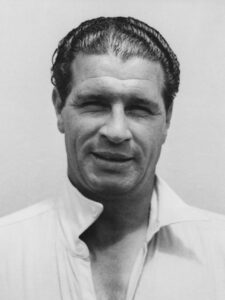 For a couple of years in the 1980s, we spent Christmas at the Savoy Hotel in a suite which enabled us to look straight down the Thames and Christmas lunch was in the Savoy Grill. One of the offspring who had taken a year off to fence in Paris and Budapest (he was actually based in the latter but had a great many contacts in the stylishly named Racing club in Paris) came over to London to have lunch with us. The food was excellent; the wine flowed; the jollification found him taking off his jacket. The Christmas cracker, suitably extravagant, yielded a parachuting man. Never mind that the son draped the parachute, to which a tiny figurine was attached, on his head so that the figurine was dangling over his nose. One of the waiters sidled up to him and murmured: “It appears that Sir’s jacket has slipped from Sir’s shoulders. Perhaps I could help Sir to put Sir’s jacket back on.”
For a couple of years in the 1980s, we spent Christmas at the Savoy Hotel in a suite which enabled us to look straight down the Thames and Christmas lunch was in the Savoy Grill. One of the offspring who had taken a year off to fence in Paris and Budapest (he was actually based in the latter but had a great many contacts in the stylishly named Racing club in Paris) came over to London to have lunch with us. The food was excellent; the wine flowed; the jollification found him taking off his jacket. The Christmas cracker, suitably extravagant, yielded a parachuting man. Never mind that the son draped the parachute, to which a tiny figurine was attached, on his head so that the figurine was dangling over his nose. One of the waiters sidled up to him and murmured: “It appears that Sir’s jacket has slipped from Sir’s shoulders. Perhaps I could help Sir to put Sir’s jacket back on.”

Ah, the good old days, when Mr Pickwick stalked the land, but the offspring did not reply to the waiter “You jest, good sir. Be of good cheer.” He obeyed and put on his jacket, and Grill etiquette was restored. The parachute remained on his head for the duration.
Yuletide Greetings Everyone.
Ernie Toshack

When I see Scott Boland bowl, with his very understated approach behind a line of more famous fast bowlers, I was reminded of Ernie Toshack, whose nickname was the “Black Prince”. He was born in Cobar and during WW11 worked in the munitions factory at Lithgow. When he was not working, he tried his hand at cricket. The man who became a member of Bradman’s Invincibles in 1948, started in the Marrickville 4th in 1941. He was initially rejected by Petersham. His progression during the war years to his first test, being against New Zealand in 1946 at the age of 32, was spectacular. Even given that the number playing competitive cricket would have been thinned by the War, nevertheless his progression to Test status was impressive. In fact he had only two years at Test level, before chronic arthritis in his knees forced his retirement. Lindwall, Miller, and perhaps Bill Johnston were the fast bowlers our generation venerates, but Toshack? He was no batsman and therefore it was his bowling for which he was selected.
He was a left arm medium pace bowler who was very accurate. It is said Bradman would walk down the pitch and put a sixpence on the pitch, point to it and say to Ernie that was where he wanted him to put the ball. Ernie would respond, which made him not only a very economical bowler but also underrated because he lacked an explosive delivery.
Toshack had an exotic genealogy. He was not of Aboriginal descent as Boland is. It is said that his ancestor was John Randall, believed to be originally a slave from the United States and a soldier who fought for the British in the American War of Independence. He arrived in Sydney with the First Fleet in January 1788. Skilled in musket use, Randall was soon employed as a hunter, sourcing wild game for the British officers.

The comparison between Boland and Toshack: they both had no whitefella heritage – one Aboriginal; the other in the parlance of our time, Afro-American. They were both very accurate medium fast bowlers, often but not always first change, came to Test cricket late – and their progression was unheralded, but their first test against England was memorable. In the first test against England in Brisbane in 1946, Toshack took 6/59; not quite the 6/7 that Boland claimed in his first test in Melbourne in 2021.
When you look at them more closely, there was not that close a comparison; I cannot see Boland affecting a bowler hat and a furled umbrella that the “Black Prince” would wear and carry. Nevertheless, when I first saw the understated Boland coming into bowl, I did think of Toshack.
Look good in a Suit
This response was prompted by the belated response to the antics of Shane Fitzsimmons, whose professional life was fenestrated by his leadership in time of disaster. This is the man who has been NSW Person of the year, and who this year at the CWA Conference said:
“I was broken during the fire season when we lost people. It was very challenging on some days: hoping for moisture, but all we got was lightning and more fires. But I was inspired by the tenacity of all the fire workers, by the tenacity of communities, by the outpouring of love and kindness of people in communities.
“My way of coping is talking openly to others about how I’m feeling,”
His speech is the type of avoidance that failure bestows upon its author. Read carefully and see no admission of accountability. This is a guy who has a formula for survival, which in the end was not enough. He was sacked last week from an organisation that did not have what its name implied – Resilience NSW.
But then he was not on his Pat Malone. Nevertheless, that is not an excuse for appointing people because they rise to the top in what are as closed an order as the Trappist monks, just different regalia.
We coined shorthand for the incompetent in high places: “looks good in a suit”.
However, let’s get to the mists of youth, a time of socialisation and when the young me became very sceptical of braid and the inherent sense of self-importance it brings.
My time in cadets at school introduced to me to a uniformed service. Being a cadet was important in my rebel socialisation. Membership of the cadet corps was virtually compulsory when I was at school, and I distinguished myself with being one of the few who went through the three years without being promoted, although I was entitled to crossed flags on my sleeves to signify that I had passed some test for the signal corps. My mate, who also was never promoted, not only had crossed flags but also crossed rifles on his sleeve to signify that he was a crack shot in the shooting team. It was a time when the school had a rifle range on the top floor of a then new building.
Perhaps it was our bringing alcohol into the cadet camp and having a brawl with senior NCOs who, in our other life, were just fellow students but with chevrons on their sleeve that gave them power in the environment of a cadet camp. Thus, when the fight broke out, I was rebelling against authority, and the fight was all the more vicious, terminated when I was hit by the butt of a rifle that night. I learnt to cop it, leave the dispute in the tent and not to complain. Any friendship I may have had within the class where there was no rank ended there and then.
Against that personal background, when I was President of the University of Melbourne Student Representative Council, I was faced with confrontation with the head of the Melbourne and Metropolitan Fire Brigade. It was the end of first term and the engineers and commerce students were having their annual “marbles match” on the lawn outside the Union building. The lawn was once a lake and therefore it took little rain to turn it into mud. The ‘marbles match” quickly degenerated, as it always did, into a form of the Eton wall game with all the combatants covered in mud. I never knew what the aim was, but I had a bird’s eye view from the SRC office.
 The “mud match” was cracking on, and there was much student activity, when the inevitable happened. Somebody broke the fire alarm in the Union, and before long, with bells ringing, the fire cart arrived driving through the milling mob in front of the Union, where it stopped. Before the firemen could get out of their vehicle, some idiot student dumped a bucket of mud over them.
The “mud match” was cracking on, and there was much student activity, when the inevitable happened. Somebody broke the fire alarm in the Union, and before long, with bells ringing, the fire cart arrived driving through the milling mob in front of the Union, where it stopped. Before the firemen could get out of their vehicle, some idiot student dumped a bucket of mud over them.
A few of us immediately went down, two of those accompanying me later became very senior judges – one of the Supreme Court and one of the Federal Court. With that amount of student firepower we were able to quieten the mob and isolate some very angry firemen covered in mud, issue an apology and offer to pay for the cleaning.
The University was a very different place, being the only one then in Victoria. Thus, it was very much a place of privilege and very much left to govern itself. At no stage did I remember police being on campus in response to any student activity, and such was the case here. A delegation, led by myself, later in the afternoon went down to Eastern Hill, where the firemen bosses were located. We were ushered in and the elderly fire chief was there glowering, surrounded by his lieutenants, all of whom affected a mixture of disdain and anger. There was no holding back as we were dressed down by this choleric elderly fire chief in his full braid. Any effort to apologise and to offer to pay for any damage was lost in a shouted invective, where top hat versus cloth cap confrontation was not far from the surface.
The newspapers were there to photograph us as we left the premises, and the incident was splashed across the front page of The Age. I do not remember being criticised by the Vice-Chancellor, with whom I met on a regular basis. It was my first introduction to a non-military uniformed service, but even at a young age I was not impressed by this braided bully, a standover merchant. OK, there are dopey students who do dopey things, but his response was completely over the top.
I was only 20, and at that age, we all move on, even if there was a post-riot hiccough, which was not related to the meeting with the fire chief. Several decades later, I was asked to review the NSW Ambulance Service. It was a time when what I knew as “ambulance driver” when I first graduated, was translating to a more professional workforce where the driver connotation had been transposed to “ambulance officer”. No longer the stretcher bearer, but a service where a cohort of newly-minted “paramedics” was being trained.
The problem was that the training was internal, there was no reciprocity between the States, and one of the teachers was reputed to have a baseball bat as allegedly one of his teaching aids. Then, within the NSW Ambulance Service, there was the “Brotherhood” – membership of which was said to be important for promotion. What was fact was that the Service had more levels of rank than the British Army. Trying to reform entrenched uniformed essential services is very difficult, even if the heads of the services are what you might call “look good in a suit”. They had risen through the services, knew all the buttons not only to polish but also to press to rid themselves of outside recommendations.
In this case, as with the hapless Fitzsimmons, it was the powers that wanted change. In our case reviewing the ambulance service, we avoided our recommendations being debated in the media. The most significant recommendation apart from reduction in the number of ranks, was to establish university-based paramedic training courses, which then led to reciprocity across the States – and at that time in the NSW Ambulance Service, an improved standard in leadership was implemented, and the ranks collapsed into a fewer number where competence trumped time in the service.
The NSW government has made a very definite and welcome decision to abolish Fitzsimmon’s empire. No worry, he’ll still look good in a suit with all those medals he gleaned as he floated to the top.
The New Health
The central objective of insurance – the removal of uncertainty – cannot be achieved through a cash reimbursement scheme unless the fees against which the benefits are paid are also predictable – R.B. Scotton 1969.
The common misapprehension about the Australian health system, whether it be called Medibank or Medicare, is that it sets the fees for doctors, because that is how the Federal Government intervention is interpreted.
The Grattan Institute is at it again. The Australian health system is built around providing a patient benefit for medical services, which are provided by doctors who are working in private practice. The Grattan Institute has a solution, so simple that the media can understand. I for one am bemused by the comment that “GPs should be able to choose a new funding model that supports team care and enables them to spend more time on complex cases, by combining appointment fees with a flexible budget for each patient based on their level of need.” Compare this confused thinking with succinctness of the late Dick Scotton above.
The Constitutional Amendment in 1946 enabled the Federal government to provide medical, dental, hospital and pharmaceutical benefits. No government has taken the opportunity to set up a universal dental system, (and that deserves a separate discussion), hospital benefits which are not at present available, instead the Federal government provides funding for the States, but the area of Federal-State relations unfortunately has become one area of significant double-dipping. The whole area of State-Commonwealth relations has been very fraught; the answer to double-dipping has been to look the other way and not proscribe this scam. Much of this playground developed in Victoria when Kennett was Premier.
Pharmaceutical benefits provide subsidised drugs on a schedule of benefits. That is the invariable, that is if the government sets a benefit it needs to provide a list of value of benefits. This has also been an area where special pleading for very expensive drugs has the form of a lottery, where who you know is of as much importance as proven efficacy of the drug.
Then there are medical benefits, which are the core of the health system, whether it be the initial Earle Page iteration or the post-Nimmo Inquiry, Medibank or Medicare, the architects of which were the late John Deeble and Dick Scotton.
 The core of these later proposals was universality. Every Australian was entitled to free care – medical and hospital care; and for pensioners and other poor people identified, free drugs provided they were on a benefit schedule or made available through a hospital pharmacy. The government set a tax levy to cover the cost of Medicare.
The core of these later proposals was universality. Every Australian was entitled to free care – medical and hospital care; and for pensioners and other poor people identified, free drugs provided they were on a benefit schedule or made available through a hospital pharmacy. The government set a tax levy to cover the cost of Medicare.
When there is an open funding model coupled with changes in the technology to improve the efficiency, if these are not appropriately monitored, as has occurred, then the result can mean the funding model is now completely out of whack.
Any system which pays on the basis of benefits has a major subjective element. If you base it on the fair and reasonable fee that a medical practitioner charges, the value of the benefit is dependent on the particular segment of the profession being as objective as can be in the value of the treatment. In the initial establishment of the benefits, the ophthalmologists based their “fair and reasonable fee” on the highest charging colleague in the country, which produced an exaggerated benefit. This was 1971 and with time any improvement in technology that improved throughput made the benefit more lucrative. Nevertheless, it did not prevent most ophthalmologists currently charging far more than the patient benefit.
Despite an increasingly elaborate medical benefits schedule, a doctor can charge what he or she likes as long as it can said to be “fair and reasonable”. The benefits schedule was also constructed to provide a small incentive for bulk billing, for which swiftness and surety of government payments was the reward. The Schedule benefit for general practitioners has encouraged turnover and episodic treatment, and therefore the Schedule has become an object for gaming. This applies particularly to all consultations, pathology and imaging.
Procedural medicine is divided into diagnostic and curative/palliative. At the outset the benefits schedule was also constructed for professional services. One of the consequences of the increasing differentiation of medicine is the increase in the number of procedures which, in turn, has led to the increase in the size and complexity of the Schedule list, and consequently tracking benefits against the fees charged requires collection of data.
Yet an immense amount of time is spent determining the value of procedures, using varying levels of evidence, as if each item has a unique fee. That may be correct, but the government is concerned with providing a range of patient benefits commensurate with what the item of service is worth.
Once the benefits and the fees for procedures were more or less aligned, but that has changed. Over time there has been dislocation of the fee charged from the patient benefit accepted as full payment by the proceduralist. Those who cannot afford the added impost end up on a public health care waiting list. Added to this, the payment for prostheses has never been properly codified for benefit payment. There are resultant anomalies. Dressings for chronic skin infection are not covered by benefits – either Medicare or private health. The whole benefit for this area has never been satisfactorily confronted, while the number of prostheses continually increases.
Once general practices, imaging and pathology services were Australian owned – essentially cottage industries – but the profitability did not go unnoticed by business and gradually the multinationals have bought up the practices. Medicare funding thus is allegedly ending up in offshore funds. In other words, the Medicare system is providing a means exported profits. These hedge funds and other financial vehicles do not invest to lose money. In other words, Australian government funding is providing sustenance to those “altruistic entities” located in the Cayman Islands and its ilk.
The system needs re-structuring. Recently yet there has been a seemingly endless review headed by Bruce Robinson, which seems to have become arcane groups of specialists debating the equivalent of angels on pinheads. It was supposed to review the health system and hopefully repair the system. Like so many of the reviews since Nimmo and after the last AMA-Government Inquiry in 1984, money is funnelled into the big consultancy firms, many of which are peopled by former public servants, for little result in terms of improved health care.
The central agency nightmare is if the Benefits system is extended to the whole raft of health professionals, other than those as specified in the constitutional amendment. However, a “weasel clause” came in 1974 with the extension of a limited patient benefit to optometry, by “deeming optometry services medical”. The inclusion of health professionals since then has been based on them being undertaken under “medical supervision”.
These professions wish to have independent access to items that generate patient Medicare benefits, and many would object to the “deemed medical” rubric as infringing on each individual skill set. However, to my mind any such benefit systems could be challenged on constitutional grounds. The community indignation which would ensue would likely be such that a resultant constitutional amendment put to referendum would be overwhelmingly passed and the resultant floodgate of expenditure would provide the Federal government with potentially massive expenditure – and headache.
There are exclusions from Medicare benefits – in other words, government can exclude procedures or anything they deem ineligible, as has been done with most cosmetic surgery. Limitations on the number of courses of IVF treatment are imposed. This can be a blunt object, and with every inclusion or exclusion there inevitably are grey areas – and controversy.
My view, after many years of being involved with Medicare, is that the construction of the benefits list is all important, and patient benefits need to be clearly differentiated for the purpose of calculation into four components. The three traditional components are professional, technical and capital, to which I would add the educational component to boost the value of the benefit for consultative medicine. Technical and capital component can be calculated based on actual cost, providing that the ratio between actual use and capacity does not allow windfall gain. Professional is how much a person’s skill and time taken are calculated. Educational component takes into account concomitant teaching occurring when the doctor is consulting and has been the basis of a submission I made to government some years ago. Then, instead of valuing each individual item of service, the government could consider providing the benefits on the basis of bands: one for episodic treatment for acute cases and second, courses of treatment for the chronically ill.
Patients’ benefits can be set either based on episodes, (predominantly acute – e.g. appendicectomy) or courses of treatment (predominantly chronic e.g. radiotherapy for cancer), or a mixture of both ( e.g general practitioner attendances). This would enable the schedule to be collapsed in a range of benefits, based on the above considerations. It is a pity that the AMA no longer has expertise in this area, because this was the basis of the AMA / Government Inquiries where neither the AMA nor the Department was asleep at the wheel.
Because of the indifferent quality of the Health Ministers since Michael Wooldridge, with surprisingly the possible exception of Tony Abbot, the Health Department has little desire to be involved in health financing – at least seriously – and increasingly finds itself at the mercy of the financial strictures of the “central agencies” – so very little changes unfortunately and thus neglecting the truism incorporated in Dick Scotton’s prescient words over 50 years ago.
A reminder of what I wrote in my blog
As I write this blog on Easter Sunday, maybe Albanese will start to rise to the task; and the proposal for an Integrity Commission is a very good place for him to start.
One thing he should remember is to pick on the topic where the Government is vulnerable and then hammer it. Add a pinch of climate change and the country being held to ransom by the very wealthy “oligarchs”, whose wealth has been tied up in fossil fuels, and the formula becomes stronger. However, whether Albanese can dispense this prescription will unfold over the next little while.
The problem with “over a next little while” is it is as long as a piece of string – as short as a piece string for that matter.

One great advantage Albanese has is, in one word, Dutton, completely unelectable outside Queensland. A second great advantage is the former Prime Minister, who should relinquish his electorate of Cook and this time have a long holiday evangelising outside Australia, under volcanoes reminding him of his fire and brimstone Pentecostalism. Hawaii – the Big Island would be a good start.
Mouse Whisper
A civilised community exists on a basis of trust.
 When you destroy that trust, then in the end you believe in nobody. You are in a dark forest inhabited by the symbols of demons or warlocks or any of the representations of Beelzebub, because they are the enemy – and you alone are the symbol of purity. What has happened to America is a man with artificial golden mane, golden face, golden geegaws (unsurprising given from ancient times religious icons are smothered in gold) burst upon a country, already conspiracy ripened by the pastors of the Second Coming and satanic interpretations of the Book of Revelations. Coupled this with those playing in the shadow isolation of video violence and how can anybody trust anybody. In the end the one supreme person who did not trust, who never trusted the law, did not understand impartiality reigns supreme with all the bodies whom he/she/it did not trust littered all around.
When you destroy that trust, then in the end you believe in nobody. You are in a dark forest inhabited by the symbols of demons or warlocks or any of the representations of Beelzebub, because they are the enemy – and you alone are the symbol of purity. What has happened to America is a man with artificial golden mane, golden face, golden geegaws (unsurprising given from ancient times religious icons are smothered in gold) burst upon a country, already conspiracy ripened by the pastors of the Second Coming and satanic interpretations of the Book of Revelations. Coupled this with those playing in the shadow isolation of video violence and how can anybody trust anybody. In the end the one supreme person who did not trust, who never trusted the law, did not understand impartiality reigns supreme with all the bodies whom he/she/it did not trust littered all around.
On that cheerful note…
Happy Christmas from Mousehole.

